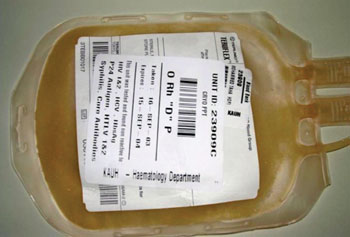Fibrin Network Changes in Neonates After Cardiopulmonary Bypass
By LabMedica International staff writers
Posted on 22 Mar 2016
Quantitative and qualitative differences in the hemostatic systems exist between neonates and adults, including the presence of “fetal” fibrinogen, a qualitatively dysfunctional form of fibrinogen that exists until one year of age.Posted on 22 Mar 2016
The consequences of “fetal” fibrinogen on clot structure in neonates, particularly in the context of surgery-associated bleeding, have not been well characterized. The sequential changes in clotting components and resultant clot structure in a small sample of neonates undergoing cardiac surgery and cardiopulmonary bypass (CPB) have been examined.
Scientists at North Carolina State University (Raleigh, NC, USA) and their colleagues collected blood samples were from 10 neonates before surgery, immediately after CPB, and after the transfusion of cryoprecipitate, which was the adult fibrinogen component. Clots were formed from patient samples or purified neonatal and adult fibrinogen. Clot structure was analyzed using confocal microscopy.
Clots formed from plasma obtained after CPB and after transfusion were more porous than baseline clots. Analysis of clots formed from purified neonatal and adult fibrinogen demonstrated that at equivalent fibrinogen concentrations, neonatal clots lack three-dimensional structure, whereas adult clots were denser with significant three-dimensional structure. Clots formed from a combination of purified neonatal and adult fibrinogen were less homogenous than those formed from either purified adult or neonatal fibrinogen. The study also showed that clots of neonate fibrinogen dissolve about twice as quickly as clots formed from adult fibrinogen. It also showed that clots formed from an adult and neonate fibrinogen mixture dissolved at approximately the same rate as adult-only clots—regardless of the percentage of neonate fibrinogen in the mixture.
The authors concluded that significant differences exist in clot structure between neonates and adults and that neonatal and adult fibrinogen may not integrate well. These findings suggest that differential treatment strategies for neonates should be pursued to reduce the demonstrated morbidity of blood product transfusion. Nina Guzzetta, MD, an assistant professor and corresponding author of the study said, “This suggests that using adult fibrinogen in neonatal patients may pose an increased risk of embolism or other adverse thrombotic events. This work drives home that newborns are not just small adults, and we still have much to learn about clotting in neonates. It also tells us that there is a great deal of room for improvement in the current standard of care for postoperative bleeding in neonates.” The study was published in the February 2016 issue of the journal Anesthesiology.
Related Links:
North Carolina State University
















